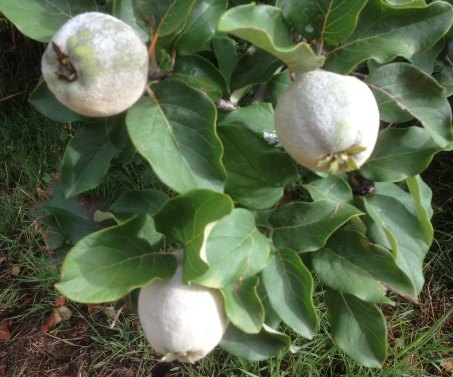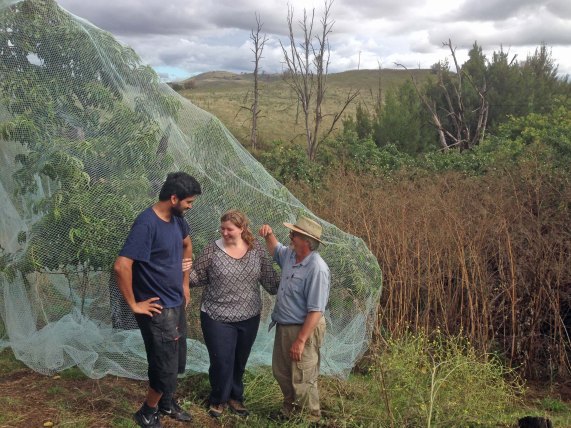In the last couple of years we’ve netted the most accessible of the peach trees that have naturalized along Mullion Creek to keep the cockatoos from eating them. The whole operation is worse than trying to get a giant bride and her veil through a forest.
 Four people were needed (one of them tall) and a lot of long poles. The trick is not to twist your ankle, fall into the wombat hole, the thistles, or in among the blackberries that grow lower down the bank. Last year Charles tried throwing the net over using a tent pole as a javelin, resulting in a snarl of unreachable netting at the top. This year we modified the system to prod the net over and then wrap it around.
Four people were needed (one of them tall) and a lot of long poles. The trick is not to twist your ankle, fall into the wombat hole, the thistles, or in among the blackberries that grow lower down the bank. Last year Charles tried throwing the net over using a tent pole as a javelin, resulting in a snarl of unreachable netting at the top. This year we modified the system to prod the net over and then wrap it around. 
I’ve heard that using flexible electrical conduit curved into hoops can make netting easier, but this tree is pretty high and awkwardly placed for that. Also, you’d have to pre-plan.
 Last year I netted some of the quince trees as well, but it turned out not to be worth it. They tasted of nothing. Possibly that was because of the heavy rain in February. They grew impressively enormous though.
Last year I netted some of the quince trees as well, but it turned out not to be worth it. They tasted of nothing. Possibly that was because of the heavy rain in February. They grew impressively enormous though.
The peaches, while they’re usually too tough for eating fresh, are good stewed, frozen or bottled and are a cheerful reminder of summer in midwinter.
Getting nets off again in the autumn can be a hassle. The grass grows through at the bottom weighing it down, the twigs grow through at the top. I had to knot up quite a few holes this year, including one where Craig cut free a brown snake that had got itself caught. He pinned it down while he snipped it, carefully, free. At the recent RFS meeting a neighbour looked at him thoughtfully and remarked “A black snake, I’d free that, but a brown snake, I don’t think so.”
Those peach, quince and plum trees were planted down by the creek probably by the Davis family back in the late 1800s, when few houses had water tanks or much garden water. I’d do that too if I only had buckets to keep a tree alive. Also, if that was the only way to get fruit.
Probably that house was some sort of wooden slab hut that’s completely rotted away now, leaving behind only the trees they planted.
There are also some wonderful fig trees in a damp spot where a gully comes down towards the river, and a different gully near the house there are masses of tiny bitter cherries that are frustrating to cook with, but make okay cherry sauce if you can be bothered. Blackberries grow all over, but they’re dropped by birds and no particular sign of an old house.
On Adnamira the only fruit tree away from the much newer house orchards is an apple that grows almost opposite the modern Esdale homestead. When we first came there it was surrounded by invasive briar roses. Its fruit is small, tart and dry. Nearby, ragged rows of dried up sweet corn showed where a market garden had been in operation for several decades. The apple tree may have had a longer history, though, as fruit trees often show old house sites.
“On the opposite side of the river to our house (said Rosa Learmont nee Davis in her 1980s memoir) was the site of McCarthy’s hut, the shepherd who was murdered in 1876 by “Waterloo” Tom Robertson. McCarthy’s grave is a little further along on the river bank, unmarked. As a child I had always looked, unsuccessfully, for McCarthy’s “ghost” which reportedly appears as a white bull. It is only in the last 20 years I have read the story as reported in J Fearn Wannon’s “Australian Folklore” – The White Bull of the Washpan.”
I haven’t been able to find that story, but spent a few hours in the paddock one day wandering up and down and trying to spot an unmarked grave. Since it was unmarked, I didn’t find it. I’m assuming she doesn’t mean the small cottage that still exists on Adnamira, because that wold have been in existence and not a “site”. And of course, I’m still wondering why a ghost would come back as a white bull. Very strange.
Meanwhile, we will take great pleasure in picking our historical peaches when they ripen in March. 

Here is the Yass White Bull story. Is Washpen creek on your property? I’m writing a song about the story for my Yass history album. https://www.scribd.com/document/33489377/Ghostly-White-Bull
LikeLiked by 1 person
Great, thanks. This version is very lively, much more so than the 1970s rewrite I got from the Yass Archive in a digest. It’s a wonderfully over the top story with some very strange aspects. I believe that McCarthy’s hut was at Jeir Creek at Yeumburra. I don’t think the creek was called Washpen, because many creeks had washpens, where the sheep would be washed before shearing in those days. There is McCarthy’s Road near the river off the end of Wallaroo Road, which may be related in some way, however. At the time I wrote this blog I was taking the “just across the river” in the Davis family memoir a little bit too literally – seems that included a couple of kms away.
LikeLiked by 1 person
Thanks for writing back, here is the finished song with some links to other sources about the story. From what I can read, especially in the Shumack bio, the incident was more likely to have been near the end of Ginninderry Creek, where the Palmerville Estate was (near Gorromon Ponds). https://youtu.be/J-DpdsVAxjI
LikeLike
Very funny, I’ve had similar experiences trying to net a cherry tree to the immense amusement of the neighbours. Later that year I had to cut free a wattle bird that had become tangled in the net, and since then we haven’t used nets, just let the birds eat the cherries.
Re white bulls, this seems to be a thing, there’s a poem about it that includes the line
“I’ve still to meet the bloke who rode
The big white bull through Wagga”
(the whole thing is here http://www.poetryexplorer.net/poem.php?id=10126320). I’ve heard people sing it.
LikeLike
Yes, nets are certainly double-edged, or multi-edged and very tangly. I do like getting fruit, though. Now I have my dwarf peaches and nectarines producing, they’re much easier to net and I get 40 to 50 pieces off each. Quite satisfying. I don’t know how they did it in the old days when it was a full days ride to town to buy fruit if you didn’t grow it. Probably spent a lot of their time running around screaming at the cockatoos like my mother used to do. Not that the cockies take any notice.
I did find the original story about this white bull, but I like the idea of someone riding one through Wagga. I suppose they meant a type of Murray Grey, maybe.
LikeLike
Dwarf fruit trees would certainly help! Perhaps it was an albino bull? My father was interested in Australian songs and poems from the early days of settlement and he used to belt this one out, but I never asked him about it. Too late now.
LikeLike
And here’s one version of the history, http://www.riverinaleader.com.au/story/1419463/legend-of-buffrey-revealed/
Don’t know if it’s the whole story 🙂
LikeLike
That’s fascinating. It certainly seems like a ‘white bull’ was something significant and special. At any rate you could see them at night, although they wouldn’t have the problem of trying to dodge them on the roads at night the way we do now. I find black Angus cattle a real menace. I talked to the Yass Historical society and got the whole local “white bull of the washpen” story, although it doesn’t completely make sense to me. I’m just waiting for permission from the historian who put it together before I put in on my blog. At least I’ve found out what a washpen was – a spot in the creek where they drove in the sheep to wash them before they were shorn.
LikeLike
Thanks! I love the idea of the legacy of history through the plants that are left behind…
LikeLike
Nowhere near as historic as your peaches but I wrote something about a “fossil tree” of the 1940 that grows is my garden – a mid twentieth century fashion item. Really fascinating…
https://berowrabackyard.wordpress.com/tag/fossil-plants/
LikeLike
I love your article about fossil trees. The pictures are quite eerie when you think about their age and history, and all the thought that went into planting them. My brother had a dawn redwood in his garden, probably from the 1940s also, and got the same reaction from neighbours and passers-by each autumn: “Your tree has died. How sad.” It’s such an act of faith to plant a tree that you may never see grow to its full glory. Our neighbours in Brisbane had a fantastic mango tree that was given to them as a wedding present when they moved into their house, brought down from Bowen by the husband’s Dad in an old tin and carefully planted. Mind you, the husband broke his neck (but survived) picking mangoes from that tree fifty years later.
LikeLike